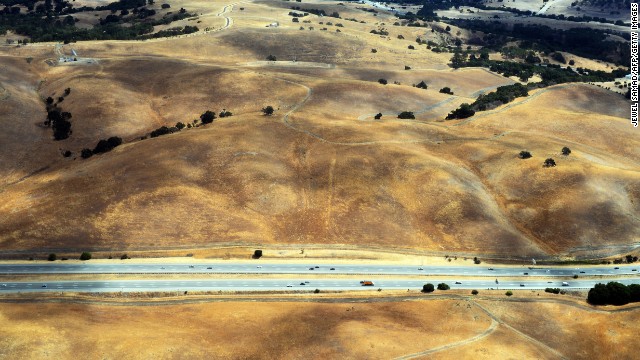Steve Arthur works in California's San Joaquin Valley, drilling for water wells on drought-ravaged farms and ranches.
"It's just going crazy; people are starting to panic," said Arthur, the owner of Arthur & Orum Well Drilling Inc.
Arthur said he is now drilling three times as many water wells.
 Photos: California's historic drought
Photos: California's historic drought
"You go to the city, and
some people don't know there's a drought," he told CNN. "Then they pay
more for their milk, and they realize this drought is making it more
expensive for these poor farmers to put food on your table."
It's a problem that extends well beyond agriculturally rich California.
The U.S. Department of
Agriculture predicts some meat and produce prices will rise as much as
6% as farmers pay more money to water crops and feed livestock. Earlier
this year, beef prices hit a record high, and milk, butter, eggs, fruit
and vegetables were also on the rise as the drought continued to ravage farms.
Avocados could increase
as much as 35 cents each, lettuce could increase up to 62 cents per
head, and tomatoes could jump by 45 cents, up to $2.84 per pound, according to an analysis by professor Timothy Richards of Arizona State University's W.P. Carey School of Business.
The fast-food chains Chipotle and In-N-Out Burger have already raised prices, partly blaming the drought.
The lack of rain has pushed most of California into extreme or exceptional drought, the two worst levels, according to the U.S. Drought Monitor.
Mandatory and voluntary water conservation programs have been implemented throughout the West.
Some cities have
restricted residential water use, shut off public fountains and even let
the grass in parks die. In mid-July, California officials approved statewide emergency water restrictions. The restrictions go into effect Friday, and infractions could bring fines of $500 per day.
In California and beyond, shrinking lakes show just how bad things are.
It's an inverse ripple effect -- the fresh water keeps draining, sucking down with it tourism business.
Kern River Outfitters
shut down its entire rafting operation this year because attempting to
paddle downstream would have been a dangerous, futile effort over
exposed Kern River rocks.
"The California drought
has reduced projected Kern River flows to a level that is inadequate to
run the top-quality rafting trips our guests expect," the company's
website says.
At many lakes, now landlocked boat docks are upward hikes from the water.
Campers Ed and Barbie
Perkins sat in lawn chairs just 3 feet from the shore of California's
Lake Nacimiento, which has receded to 81% of its capacity.
"Normally we'd be way
under water," Barbie Perkins said from their campsite. "You would be
able to drive your boat here. You would not be camping down here."
In Nevada, Lake Mead is
at its lowest level since the dam was built in the 1930s. The lake
supplies water to parts of Nevada, Arizona, Southern California and
northern Mexico, and the supply is disappearing.
"I think it's important
for people to realize water is a finite resource," said Rose Davis, a
spokeswoman for the U.S. Bureau of Reclamation, Lower Colorado Region.
"When you turn on the tap, it does not just magically appear. It has to
come from the Colorado River."
In Santa Barbara,
California, a program to reduce or stop watering in public parks has
turned once pool-table green swatches of lawn along the waterfront into
patches that look more like burlap.
At Hearst Castle in San Simeon, the iconic Neptune Pool sits empty.
Sparkling blue water has given way to a skateboarders' dreamland and a reminder of horrific drought. LINK


